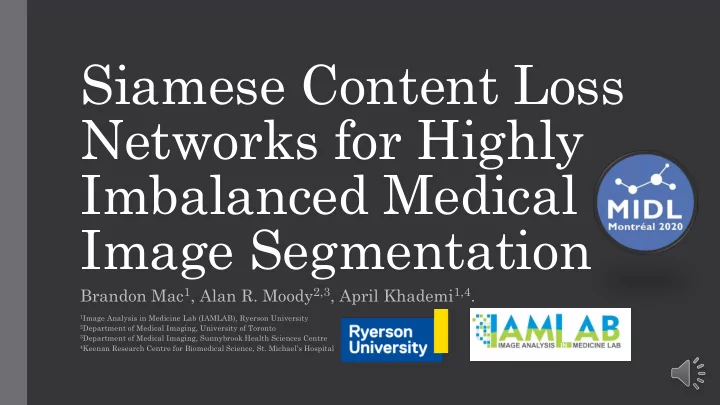

Siamese Content Loss Networks for Highly Imbalanced Medical Image Segmentation Brandon Mac 1 , Alan R. Moody 2,3 , April Khademi 1,4 . 1 Image Analysis in Medicine Lab (IAMLAB), Ryerson University 2 Department of Medical Imaging, University of Toronto 3 Department of Medical Imaging, Sunnybrook Health Sciences Centre 4 Keenan Research Centre for Biomedical Science, St. Michael’s Hospital
Clinical Problem • White Matter Hyperintensities [1] ➢ Local macroscopic tissue structure erosion ➢ Increased water content due to inflammation • Key Biomarker ➢ Linked with stroke and dementia • Typical analysis is manual ➢ Time consuming and expensive ➢ High inter- and intra- rater variability ➢ Reported DSC of 0.66 [2] – 0.83 [3] between radiologists • Our Method ➢ Trained on: MICCAI 2017 WMH Grand Challenge Data (60 Volumes) ➢ Validated on: Canadian Atherosclerosis Imaging Network (50 Volumes)
Class Imbalance Across Subjects Positive Pixel Ratio Across Subjects 1.2 1 Postive Pixel Ratio (%) 0.8 0.6 0.4 0.2 0 Subject
Method – Overview
Method – Generator
Method – Discriminator
Results – Segmentation
Results – Dice Scores
Results – Average Volume Difference
Future Works • Explore configurations of the discriminator network • Explore GANs and Deep Metric Learning methods Min Max
Thank you for Watching Brandon Mac Alan A. Moody April Khademi IAMLAB University of Toronto IAMLAB Ryerson University Sunnybrook Health Ryerson University bmac@ryerson.ca Sciences Centre St. Michael’s Hospital @BrandNameTensor alan.moody@sunnybrook.ca akhademi@ryerson.ca @aprilkhademi
References [1] H. J. Kuijf et al, "Standardized Assessment of Automatic Segmentation of White Matter Hyperintensities; Results of the WMH Segmentation Challenge," IEEE Transactions on Medical Imaging, vol. 38, (11), pp. 1-1, 2019. [2] C. Egger et al , "MRI FLAIR lesion segmentation in multiple sclerosis: Does automated segmentation hold up with manual annotation?" NeuroImage Clinical, vol. 13, (C), pp. 264-270, 2017.[3] T. Falk et al, "U-Net: deep learning for cell counting, detection, and morphometry," Nature Methods, vol. 16, (1), pp. 67-70, 2019. [3] M. D. Steenwijk et al , "Accurate white matter lesion segmentation by k nearest neighbor classification with tissue type priors (kNN- TTPs)," NeuroImage. Clinical, vol. 3, pp. 462-469, 2013.
Recommend
More recommend